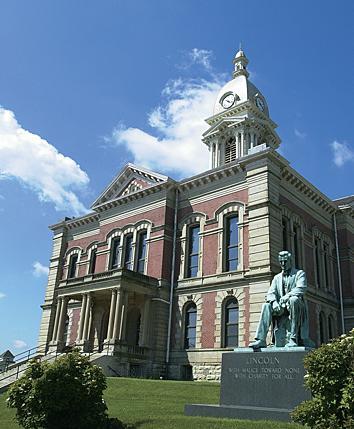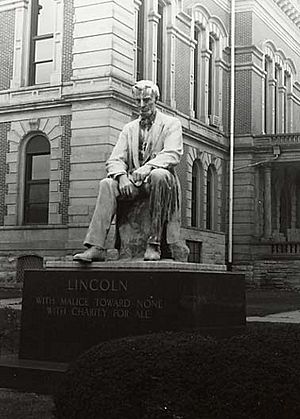Lincoln Monument (Wabash, Indiana) facts for kids
Quick facts for kids The Lincoln Monument |
|
|---|---|
 |
|
| Artist | Charles Keck |
| Year | 1932 |
| Type | Bronze sculpture |
| Location | Wabash, Indiana |
The Lincoln Monument of Wabash, Indiana or The Great Emancipator is a famous public statue. It was created by Charles Keck, a talented sculptor from New York City. This large bronze statue was paid for by Alexander New, who grew up in Wabash. He gave it to the city of Wabash, Indiana, in 1932. You can still see it today on the northeast corner of the Wabash County Courthouse lawn.
Contents
About the Lincoln Monument
What Does It Look Like?
The statue shows a larger-than-life Abraham Lincoln. He has a beard and is sitting on a rock. His head is slightly bowed, and his arms rest on his knees. Both of his hands are closed, but his right index finger is pointing out.
Lincoln is wearing a bow tie, a vest, a long coat, and boots. His right boot sticks out a little past the base. You can also see his watch chain on his vest.
On the back of the bronze base, you can see a mark from the company that made it. It says "Gorham Co. Founder."
Special Messages on the Base
The front of the statue's granite base has a famous quote from Lincoln:
LINCOLN
WITH MALICE TOWARD NONE
WITH CHARITY FOR ALL
This means he wanted to treat everyone fairly, without anger or meanness.
The back of the granite base explains who gave the statue:
ERECTED IN LOVING MEMORY
OF HIS PARENTS
ISAAC AND HENRIETTA NEW
BY
ALEXANDER NEW
1932
This shows that Alexander New wanted to honor his parents with this gift.
Other Lincoln Statues by Keck
The Hingham Lincoln
The town of Hingham, Massachusetts, has a statue that looks just like the one in Wabash. It also sits on a granite base and has the same message on the front. This statue was given to the people of Hingham on September 23, 1939.
-
Front view of the Lincoln Monument of Hingham, Massachusetts, by Charles Keck
-
Back view of the Lincoln Monument of Hingham, Massachusetts, by Charles Keck
-
A close-up of the head of the Lincoln Monument of Hingham, Massachusetts, by Charles Keck
The Maquette Version
A smaller model of the statue, called a maquette, is kept at President Lincoln's Cottage at the Soldiers' Home in Washington, D.C.. This small version looks similar to the Wabash and Hingham statues. However, in this one, Lincoln holds a book in his right hand, and his hat is near his right boot.
What It's Made Of
The statue is made from bronze, which is a strong metal alloy (a mix of metals, mostly copper). It was likely cast in several pieces. The bronze statue sits on a large square base covered with granite, a very hard stone.
How Big Is It?
The bronze statue itself is about 7 feet tall. It is also about 6 feet deep and 6 feet wide.
The granite base underneath is about 4 feet tall. It is about 7 feet deep and 7 feet wide. So, the whole monument is quite large!
History of the Monument
How It Came to Be
Alexander New, who paid for the statue, grew up in Wabash. He later studied law and built a big chain of stores. His main offices were in New York.
The statue was officially shown to the public and dedicated on May 31, 1932. This day was Memorial Day. Alexander New had passed away a year before, so he didn't get to see it.
A photo from that day shows many people gathered around the statue. Some even sat on the courthouse roof to get a better look! In that old photo, the statue looked dark and smooth.
Homer T. Showalter was the mayor of Wabash when the statue was put in place. He shared his memories of the installation. He said the granite pieces and the bronze statue arrived on a train car. It took three full days to put the base together.
People even put containers with pictures and newspapers inside the hollow spaces of the base. They wanted to create a time capsule! When the statue was finally placed on top, the mayor knew it was a "masterpiece."
Its Appearance Over Time
In 1992, the statue was checked as part of a program called Save Outdoor Sculpture! (SOS!). A record was made about it. At that time, the statue didn't have the same dark, smooth look it had in 1932.
However, by June 2008, the statue looked dark and smooth again. This means its appearance had been changed more recently. The similar statue in Hingham, Massachusetts, and the smaller maquette version in Washington, D.C., also have a dark, smooth look.
Images for kids







